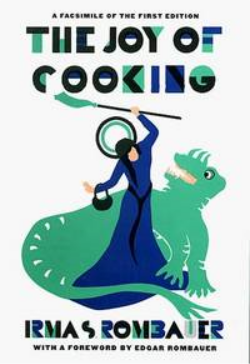


|

| <- Back to main page |
I first found the Joy back in the early ‘90s, on my mother’s kitchen shelf. It was the white sixth edition from 1975 and I borrowed it to make bread and never got around to returning it to Mom. Perhaps it was the epigraph from Goethe (“That which thy fathers have bequeathed to thee, earn it anew if thou wouldst possess it”). Or the little tips, such as: After kneading bread, turn your oven on to 300 for one minute, then turn it off, and set the bread in the oven to rise (works like a charm). Or the fact that it contained quaint retro recipes for making cereal, jarring jelly and mulling wine. And if I ever need to learn how to skin a rabbit, Joy of Cooking is there for me. Mostly, though, I loved it for the stories that the author, Irma Rombauer, garnished the book with. To give you a flavor, here’s the little preface for the Whole Wheat bread recipe (which I still make, by the way):
Feather-lightness is, of course, by no means a prime objective in making whole-grain breads. Yet such loaves should have substance without high density. If our instructions are closely followed, you will never have occasion to level at us the reproach of Mrs. Burns, who, on viewing an inexpressive monument to her illustrious son, exclaimed: “Aye Robbie! Ye asked for bread and they’ve gien ye a stane.”
The Joy is ridiculously encyclopedic—besides the recipes there are sections on how to dry herbs and carve a turkey, commentary on cabbages and forcemeat, measurements and substitutions. It’s also very compact because Rombauer, like any good technical writer, made use of cross references and indexing. Her Shepherd’s Pie (another common visitor to our dinner table) is more or less a reference to other recipes in the book:
Shepherd’s Pie
Preheat oven to 400 degrees
Prepare:
Hash, 262
Spread it in one large baking dish or in smaller individual ones. Cover with fresh hot:
Mashed Potatoes, 318
Coat with:
Melted butter
Bake until the potatoes are browned.
The Joy is not finicky about ingredients (it’s just salt, not sea salt, and pepper never has to be freshly ground). But Rombauer does go out of her way to explain the basics—as with the preface to the Baked Potatoes recipe.
We have always liked the snug phrase “baked in their jackets” to describe this process. But we are told that at least one young cook, after encountering it, called a home economist at the local utility company and complained that her grocer was unable to supply her with potato-jackets!
And she can also be pretty damn funny, as in this little aside in About Pork:
Someone has observed that a pig resembles a saint in that he is more honored after death than during his lifetime.
And this little assurance placed in a preface:
Will it encourage you to know that I was once as ignorant, helpless and awkward a bride as was ever foisted on an impecunious young lawyer? Together we placed many a burnt offering upon the altar of matrimony.
There are other personal notes scattered about the book —such as the comment, in her Hollandaise Sauce recipe that “Our cook calls this ‘holiday sauce’—isn’t that a grand name for it?”
Cook? A doyen of the cookbook world who has her own cook? Who was this Irma Rombauer, anyway?
It turns out that she was never a professional chef, and only taught one class in the 1920s—for the Women's Alliance at her local Unitarian church. She was a homemaker from St. Louis who, while taking art classes at Washington University, was briefly courted by Booth Tarkington. But she wound up marrying the aforementioned lawyer, Edgar Rombauer, in 1899, and enjoyed entertaining at various functions within their upper middle class milieu. Tragically Edgar, who suffered from bouts of depression, committed suicide in 1930, just a few months after the Stock Market crash. He left Rombauer a fifty-two-year-old widow with two grown children and $6000 to her name. The Joy was, perhaps, her own way of keeping body and soul together. Like a good bread, it took some time to rise.

It’s original title was The Joy of Cooking: A Compilation of Reliable Recipes, with a Casual Culinary Chat. The first edition, appearing in 1931, was self-published. Irma and her daughter Marion, who helped her with the illustrations, simply took it to a local printers and plunked down a check for half her savings. By the summer of 1932 she had sold about 2000 copies, personally or through the book stores and gift shops where she had it placed. Readers, apparently, responded to the “casual culinary chat” part of the book. As Cooks Illustrated founder Chris Kimball explains:
The amateur but highly evolved enthusiasm that Irma Rombauer brought to the world of home cooking was a breath of fresh air after the slightly earlier era of culinary dowagers Fannie Farmer, Mrs. Beaton, and Marion Harland. To those pillars of culinary wisdom, recipes were shorthand for cooks who had spent a lifetime in the kitchen. A pie pastry recipe might be written as "make a paste." But Ms. Rombauer was there to hold our hands, to put food in a social context and give it attitude, energy, and meaning in a world where food was leaping past the narrow formality of the Victorian age.
By 1936, the Joy had become successful enough to interest a publisher, the Bobbs-Merrill Company. The second edition had a new layout with ingredients listed as they arose in the recipe directions rather than all above the directions. Although Bobbs-Merrill were able to market Joy of Cooking into a bestseller, the contract basically gave them the rights of the book in perpetuity and entangled Rombauer in legal battles for the rest of her life.
The 1943 edition of the Joy included sections on coping with wartime rationing restrictions, including alternatives to butter. By then Irma Rombauer had attained national celebrity as “one of the eternal verities of American cooking.” At her famed meeting with Julia Child in Paris, around 1952, it was Rombauer who dished out advice to the then-unknown Child.
Marion Rombauer Becker took over as co-author in the 1951 edition. A woman ahead of her time, Becker was a healthy eating advocate who favored whole grains and fresh produce rather than canned goods. It was perhaps she who added this note in the “About Dry Heats” section, showing how the horizons of the Joy had broadened along with post-war America:
If you are an American housewife you may have added to your wanted-for-Christmas list a wok... Ironically enough, most of the East Asian brides living in our area happily substituted for it some while ago a good old-fashioned skillet with a tight-fitting lid.
Irma died in 1962, the year a new revised edition appeared; the most popular, however, was the white 1975 sixth edition that I own. Scribner tried to remake the Joy in 1997, under the direction of cookbook editor Maria Guarnaschelli and a team of chefs—but unseasoned by Rombauer’s wit and asides, it was like a bland, unsavory tart. The original content was restored for the 75th anniversary edition in 2006, overseen by Marion’s son, Ethan Becker, a knife designer and outdoorsman who studied Cordon Bleu in Paris. There’s even a Joy of Cooking website (thejoykitchen.com) and—get this—a phone app. Altogether the Joy has sold more than 18 million copies over the years. Not bad for a “kitchen chat” that imparted some Napoleonic history while teaching you how to cook up Chicken Marengo.
Cookbooks are not typically included in the literary canon, but I would place Joy of Cooking on the Classics shelf next to Montaigne and Samuel Pepys, were it not so indispensable in the kitchen. Sure, there are other cookbooks dear to my stomach. The Good Housekeeping Illustrated Cookbook is worth its weight in pine nuts, and James Peterson’s Cooking is worthwhile simply for its beautiful photographs. The Time-Life Foods of the World cookbooks have taken me on many a culinary voyage, Slow Cooking for Two is opened weekly in our kitchen, and I’m a devout follower of the Flat Belly Diet! book, even though I’ve never been on an actual diet. But the Joy is in a different class; it’s one of those books that seems to effortlessly straddle the boundaries placed between genres, connecting the past to the present through its recipes and long publishing history. One part recipe book, one part food science, adding a tablespoon of personal anecdote, a teaspoon of literature and a pinch of history, the Joy brings the kitchen to life, raising cooking to its rightful status of a Great Art. As Marion Rombauer Becker writes in the Preface to the sixth edition:
Using this information, you may say with Thomas Jefferson, “No knowledge can be more satisfactory to a man than that of his own frame, its parts, their functions and actions.” Choose from our offerings what suits your person, your lifestyle, your pleasure; and join us in the joy of cooking. 